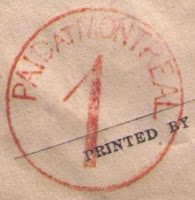Handstruck Paid Stamps



Examples of Canadian "Postage Stamps". The Quebec "Paid" handstamp, on the left, is an example of a handstruck postage stamp. The three pence beaver is an example of an adhesive postage stamp.
Although the three pence beaver, issued in 1851, is considered by most philatelists to be Canada's first postage stamp, it really isn't. According to Winthrop Boggs (The Postage Stamps and Postal History of Canada,1945), the first postage stamps were actually the handstruck postage markings struck on prepaid letters. The three pence beaver, of course, was Canada's first adhesive postage stamp. It is interesting to note that postmasters did not like using the new adhesives, as Fred Jarrett explains in his 1929 reference book Stamps of British North America, at p. 465:
"Postmasters, did not take kindly to the use of adhesive stamps which had to be cut from the sheet, sold to the customer, and then defaced with a cancelling instrument.They claimed a commission on stamps sold, and not receiving it they preferred to collect the rate in cash and stamp the letter "PAID" opposite the amount of the postage. This meant less bookkeeping for the postmaster. "This explains why handstruck postage stamps continued to be used for almost 25 years after the introduction of the adhesive stamp. The use of adhesive postage stamps finally became compulsory in 1875:
"...three cents shall be prepayed by [adhesive] postage stamps at the time of posting the letter otherwise such letter will not be forwarded by post." Post Office Act 1875
This post deals with the handstruck postage stamps in use during the pre-stamp (to 1851) and stampless (1851-1875) periods, and is organized as follows:
1. Paid Handstamps
2. City Types (No values)
3. Paid Handstamps with values in pence
4. Paid Handstamps with values as numerals
5. City Types with values
6. Decimal Currency period handstamps
a) Paid 5 (1859 - 1868)
b) Paid 3 (1868 - 1875)
Articles dealing with pre-stamp and stampless mail rates can be found here.
1. Paid Handstamps
Letters could be mailed prepaid or unpaid.

Paid 7d
The above is a typical marking indicating that the letter rate was paid.
Dundas


Dundas to Toronto, August 5, 1834
Paid 4 1/2d. : 0 - 60 miles rate
Montreal


Montreal to St. Catherines [sic], September 28, 1836
Paid 1s. 4d. : 401-500 mile rate
Ancaster


Ancaster to Chippewa, April 7, 1846
Paid 7d. : 61 - 100 miles rate
London


London to Woodstock, January 24, 1844
Paid 4 1/2d. : 0-60 miles rate
L'Islet


L'Islet to Woodstock, New Brunswick, February 26, 1846
Paid 1s. 4d. : 401-500 miles distance
On April 1, 1851, a 3d. per ounce letter rate, irrespective of distance was introduced.
London


London to Toronto, March 18, 1854
Paid 3d. : 3d. letter rate
Winchester


Winchester to Toronto, June 12, 1858
Paid 3d. : 3d. letter rate
2. City Types (No values)
Quebec City


Quebec to St. Antoine, August 30, 1829
Paid 9d. : 101 - 200 mile rate
Quebec City Crown Circle


Quebec to Cornwall, August 5, 1844
Paid 11 1/2d. : 201 - 300 mile rate
Montreal "Tombstone"


Montreal to St. Catharines, December 3, 1847
Paid 1s. 4d. : 401 - 500 mile rate
Quebec City


Quebec to Toronto, February 8, 1859
Paid 3d. : 3 d. letter rate
Toronto


Toronto to Hamilton, February 10, 1856
Paid 3d. : 3d. letter rate
3. Paid Handstamps with values in pence
(1851 -1859)
On April 1, 1851, a 3d. per ounce letter rate, irrespective of distance was introduced.
Port Hope


Port Hope to Toronton, December 19, 1855
Paid 3d. : 3 d. letter rate
4. Paid Handstamps with values as numerals
(Pence period: 1851- 1859)
Gananoque


Ganananoque to Brockville, June 22, 1853
Paid 3d. : 3d. letter rate
Fenelon Falls


Fenelon Falls to Toronto, June 3, 1859
Paid 3d. : #d. letter rate
5. City Types with values (Pence period: 1851- 1859)
Montreal


Montreal to Vittoria, 1846
Paid 1d. : 1d. circular rate
6. Decimal Currency period handstamps
On July 1, 1859, decimal currency became the legal system, 3 d. being equivalent to 5 cents.
a) Paid 5 (1859 - 1868)
Sarnia


Sarnia to Toronto, October 18, 1862
Paid 5 cents
Port Colborne


Port Colborne to Toronto,January 30, 1861
Paid 5 cents
Kingston


Kingston to Montreal, June 5, 1865
Paid 5 cents
Hamilton


Hamilton to Stratford, May 7, 1863
Paid 5 cents
Esperange


Esperange to Quebec, October 10, 1865
Paid 5 cents
b) Dominion of Canada
Paid 3 (1868 - 1875)
The domestic letter rate was reduced to 3 cents per one-half ounce on April 1, 1868. The use of adhesive postage stamps became more common. Although handstruck postage stamps were still allowed, no new Paid handstamps were produced. The markings shown below were those used prior to 1859 during the pence period when the letter rate was 3 pence. Since the handstamps only showed the numeral and not the currency, they could be recycled during the cents period until 1875.
Dalkeith


Dalkeith to Toronto, January 20, 1869
Paid 3 cents
Elgin


Elgin to Elora, June 22, 1869
Paid 3 cents
Watford


Watford to Toronto, April 9, 1875
Paid 3 cents
